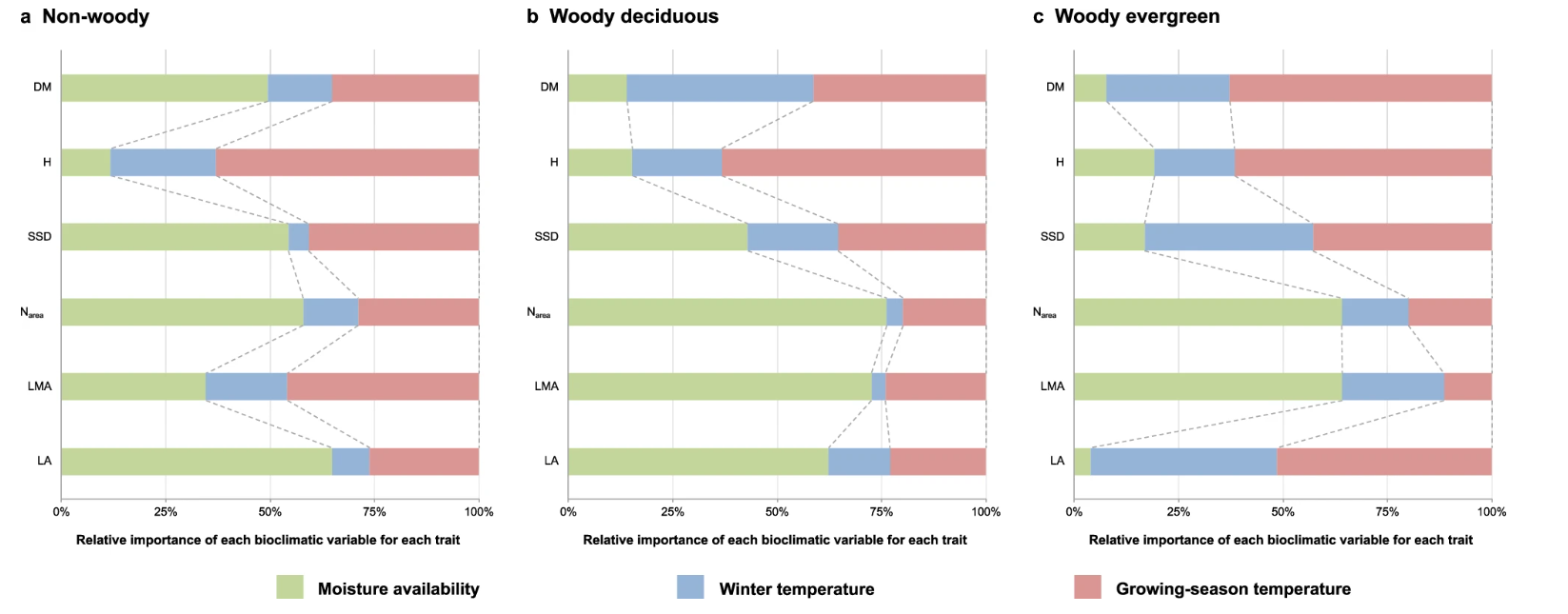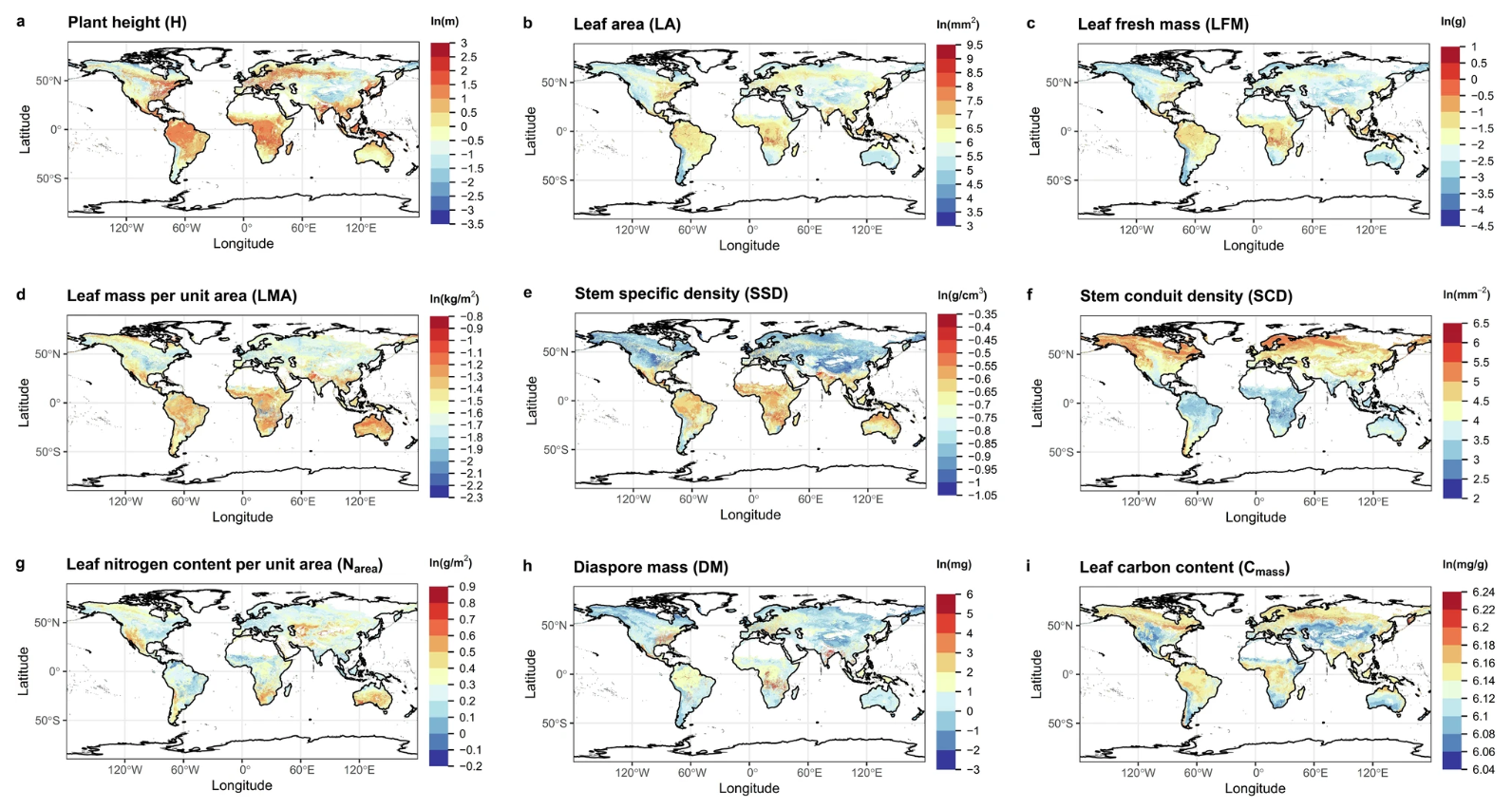Understanding how plants adapt to their environments is a crucial piece of the puzzle when it comes to predicting the future of ecosystems under climate change. The recently published study by LEMONTREE’s Jiaze Li and Colin Prentice from Imperial College London, titled Global Patterns of Plant Functional Traits and Their Relationship to Climate, offers new insights into the connection between plant traits and climate on a global scale. The study, published in Communications Biology, lays the foundation for more accurate models of ecosystem responses to global environmental change.
Plant Functional Traits and Why They Matter
Plant functional traits (FTs) are the characteristics that define how plants grow, reproduce, and survive in their environments. These traits, such as plant height, leaf size, or nitrogen content in leaves, are not just random features. They form the core strategies that allow plants to adapt to their specific climate and surroundings. FTs determine how well plants can capture light, conserve water, absorb nutrients, or disperse their seeds. The interactions between these traits have implications not just for individual plants, but for whole ecosystems.
Previous studies have revealed that certain plant traits often co-vary, reflecting different ecological strategies. For example, plants that prioritise rapid growth and resource acquisition tend to have different leaf traits from those that conserve resources for the long term. These strategies form what is known as the leaf economics spectrum (LES).
A Comprehensive Global Dataset of Plant Traits
In this new study, Li and Prentice compiled an extensive global dataset of 16 key plant functional traits. These traits were analysed across three main plant groups: non-woody plants, woody deciduous plants, and woody evergreen plants. By employing advanced statistical tools, such as multivariate analysis and generalized additive models (GAMs), they explored how these traits vary in different climates and how they co-vary within plant groups.
The study reveals that two primary dimensions—plant size traits (such as height and seed mass) and LES traits (such as leaf mass per area and nitrogen per area)—were consistently dominant across all plant groups. The significance of these traits is clear: they reflect key survival strategies. For example, taller plants and plants with larger seeds are often found in warmer, wetter climates, where competition for light is more intense. Meanwhile, traits that emphasise water conservation, like higher leaf mass per area, tend to be more prominent in dry climates.
Climate-Driven Patterns in Trait Variation
One of the study’s key findings is the close relationship between plant traits and climate. In general, larger plants and those with heavier seeds are favoured in warmer and wetter regions. This makes sense—plants in these environments can capitalize on abundant light and resources to grow taller and disperse seeds more effectively. On the other hand, LES traits such as higher leaf mass per area (LMA) and nitrogen per area (Narea) are more commonly found in dry environments, where water conservation becomes critical for plant survival.
The relationship between specific traits and climate varied between plant groups. For instance, leaf size showed different patterns depending on the plant type. In woody evergreen plants, larger leaves were associated with warmer winters, while in non-woody plants, leaf size was linked to wetter climates. This suggests that different plant types have evolved distinct strategies for coping with their respective environments, whether it’s through better water retention or protection against cold temperatures.

Figure 1: Relative importance of three bioclimatic variables. Relative importance of each bioclimatic variable in predicting six major plant functional traits of non- woody (a), woody deciduous (b) and woody evergreen (c) plants derived from Generalised Additive Models (GAMs).
Global Mapping and Predictive Models
A crucial part of this research involved using GAMs to simulate global patterns of plant traits. By considering the differences among herbaceous, deciduous and evergreen plants and how these lead to divergent climatic responses in plant functional traits, the authors have created the most comprehensive set of global trait maps based on statistical models to date. These models explained up to 77% of global trait variation, offering a robust framework for understanding how traits are distributed across the world’s ecosystems. Simulated patterns where then compared with independent trait data from iNaturalist, a popular citizen-science platform. The results showed broad agreement, further confirming the accuracy of the models.
While the global maps generated in the study align well with observed data, there were some regional discrepancies, particularly between northern temperate and southern tropical areas. These disagreements may arise from the respective sampling biases of iNaturalist and sPlotOpen, or might also be due to factors not accounted for in the models, such as soil fertility or land use changes. Nevertheless, the study’s approach marks a significant advance in predicting plant trait distributions and understanding their links to climate.

Figure 2: Examples of global trait maps.
Implications for Ecosystem Modelling and Climate Change Predictions
This study provides a critical step toward more refined ecosystem models that can predict how plant communities will respond to climate change. Current models, such as Dynamic Global Vegetation Models (DGVMs), tend to oversimplify plant diversity by grouping plants into broad categories. However, this new research shows that plant functional traits vary significantly within and between different plant groups. By integrating more detailed trait data into these models, we can better predict how ecosystems will shift as temperatures rise, rainfall patterns change, and extreme weather events become more frequent.
Conclusion
The work by Jiaze and Colin underscores the importance of understanding the fine-scale relationships between plant functional traits and climate within and among different plant groups. By dissecting the patterns of 16 key traits across various plant types, the study offers valuable insights into how plants adapt to their environments and what that might mean for ecosystems in a changing world.
To read more, you can access the full paper here:
Li, J. & Prentice, I.C. (2024). Global Patterns of Plant Functional Traits and Their Relationship to Climate. Communications Biology, 7 (1136). https://doi.org/10.1038/s42003-024-06777-3
